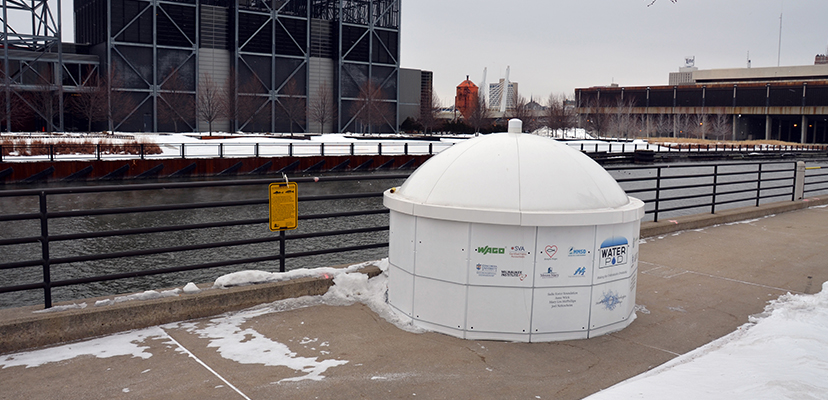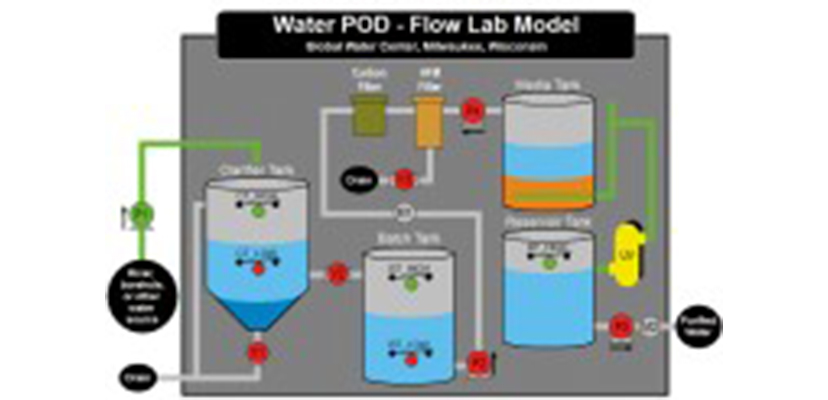


Milwaukee is often called the “Silicon Valley” of water technology. This reputation is largely based on a unique confluence of industry, academia and government, called the Global Water Center. Housed in the Global Water Center, Stonehouse Water Technologies is a solutions-driven company focused on creating systems to collect, store, treat and distribute water for a variety of uses both domestically and in developing countries.
Concerned about current and future needs for fresh water access globally, Stonehouse Water technologies created a cost-effective, modular, compact water filtration system. Stonehouse’s flagship product “The Water POD” produces 3,000 gallons of clean water for cooking and drinking from a mix of freshwater sources. One unit can provide water for up to 1,000 people, and is scalable, meaning more units can be added to serve larger populations. The Water POD solves the problem of a lack of healthy, clean drinking water in underserved and distressed populations where water contamination is the norm.
The Water POD is funded in part by the Milwaukee Water Council’s Pilot Project grant. The program is designed to act as a catalyst for young companies with scalable, cost-effective technologies that have the potential to make true social and environmental impacts. “Thanks to the Water Council and Global Water Center, Milwaukee is becoming an international hub for water. They are driving innovative ideas like the Water POD into fruition,” says Hensley Foster, President, Stonehouse Water Technologies.
Rethinking Clean Water
The majority of companies in the water sector are focused on high-pressure applications. Whether it is treating wastewater or providing drinking water, the focus is largely on using high-pressure to move large quantities of water. For applications in the developing world and underserved areas within the U.S., Foster knew that Stonehouse would have to use a different approach. “In designing the Water POD we had to rethink traditional technological solutions and factor in future conditions and maintenance needs in the areas where the Water POD will be used,” explained Foster.
Working independently of larger operators in the water sector, Foster and his team were able to create a system that is ideally suited for easy setup and operation. The Water POD consists of multiple processes to remove pathogens, bad odor, taste and viruses. Heavy metals such as arsenic are also reduced. “Stonehouse is an aggregator of a lot of different technologies. We test various options ‘till we come up with the best solutions. We are always looking for technologies that will fit in with the low-pressure, low-energy model we developed. Our technology choices have to be efficient and energy-sensitive, since we envision the Water POD being powered by solar energy alone,” explained Foster.
Technological Solutions Powered by Application Expertise
Foster brought his toughest technological challenges to WAGO North America. Working with the WAGO team, Stonehouse developed an easily scalable modular control system. The central control framework behind the Water POD is WAGO’s Ethernet 2.0 Controller the 750-881. The Ethernet 2.0 Controller gave the Water POD team the flexibility to expand or modify the system’s functionality. With more than 500 digital, analog and special-function I/O modules the team had the ability to quickly adapt the basic prototype to offer added capabilities, such as pumps, to move water through additional filtration media. Another benefit was the compact profile of the 750-881. In order to ship and set up the Water POD, a small footprint would be essential. The 750-881 is 60 % smaller than most available PLCs presenting a distinct advantage to the design team. Using the 750-881 also helped eliminate additional networking hardware. The built-in Ethernet switch in the controller allowed for line topology wiring of the Ethernet network. The 1MB of program memory and 512KB of data memory and the high-speed processing power offered by the 750-881 made it possible to store operation data and transmit it to remote monitoring applications.
Web-Based Management and Visualization
From the beginning, Foster and the Stonehouse team realized that they could not simply deliver the technology to end users in under resourced areas and wash their hands of the project. “When technology is transferred at third world levels things can get lost in translation. With the WAGO controller we have the ability to remotely monitor flow into the system which is absolutely essential because we want to be able to track the operation of the system once it is mobilized. So if a pump ever goes down, our remote monitoring can help troubleshoot and point the people on the ground to appropriate solutions,” explained Foster.
The Web-based management and visualization capability of the 750-881 allowed the Stonehouse team to remotely monitor the status of Water POD with a Web browser or a smartphone via the Internet.
With these added telemetry capabilities Water POD users can be certain that they will have reliable access to water that is 99.99 % free of bacteria, heavy metals, bad odor and taste. Foster added, “The thing that I know I can count on with WAGO is the level of expertise they bring to a project. The WAGO team will work with us to address any technical challenges we may face as we scale up production of the Water POD.”
First Deployment: the Dominican Republic
Stonehouse staff will have a chance to test their ideas in the field in the very near future. The first Water POD will be deployed to a location in the Dominican Republic, providing residents with access to clean, contaminant-free water for the first time. Anne Wick, Director of Communication for Stonehouse Water Technology sums up Stonehouses’ vision well, “It’s easy to take for granted that you can turn on a tap and have access to clean drinking water but it’s important to keep in mind that by 2050, five billion people globally will be living in water-stressed areas. Around the world a child dies every 20 seconds from consuming contaminated water. At Stonehouse we are driven by the need to be part of the solution, to make an impact on these staggering statistics. And we know that right here in Milwaukee, we have a technology partner that will work with us to make that happen.”
Conclusion
Text: Jennifer Joseph, WAGO
Photo: WAGO